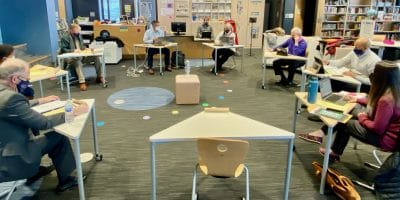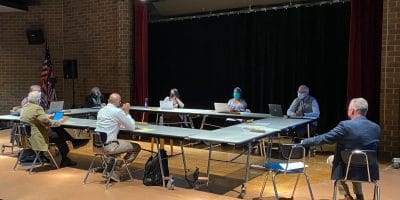By Eric Gorton, contributor
Last October, the Virginia Department of Health wrapped up a months-long tabletop training exercise for a statewide response to a novel flu pandemic.
Called “Cardinal Resolve,” the exercise outlined the responsibilities of public health agencies and community partners in conducting unified surveillance and investigation of a public health emergency. It also tested participants’ ability to develop and implement a unified strategy to manage such an emergency while minimizing the impact on the healthcare system. Cardinal Resolve even included surprises, such as vaccines arriving too warm, to practice on-the-fly problem-solving during a pandemic.
“The basics of emergency response, having mechanisms in place locally for continuity of operations and having setups where folks are familiar with command structures and how to respond to emergencies, are things health care providers train for constantly,” said Dr. Laura Kornegay, director of the Central Shenandoah Health District, during an hour-long telephone interview with The Citizen.
In addition to discussing the state’s preparedness, Kornegay addressed the challenges of responding to a novel pathogen; COVID-19 symptoms and testing; strategies for minimizing its impact while a vaccine is in development; and the dedication of VDH employees and others responding to the crisis.
“I think we were really as prepared as we could possibly be with the one twist being this is a pathogen that no humans have any immunity to,” Kornegay said.
‘Typically, we have a lot better tools’

While Kornegay characterized efforts to control and live with COVID-19 as largely successful in Virginia, she warned things could take a turn for the worse if people shy away from recommended best practices for halting the disease’s spread.
“If I had one wish for the next couple months going forward, it would be that everybody band together and do all those things that we need to do until we get those vaccines ready,” she said.
As for when a vaccine could be available, that’s still a big question. According to Kornegay, state health officials have talked about potentially having an initial vaccine in small quantities this fall , which would be given to healthcare providers and other first-line responders, with availability for the general public possibly arriving in early 2021.
“I don’t think anyone could say that’s a firm timeline, but that’s kind of what we’re anticipating and gearing up for,” she said.
Until then, Kornegay said people should continue to follow the recommendations that have become our new normal: practice social distancing by remaining six feet apart, wear face masks in places where social distancing is impossible or difficult, and wash hands often with soap and water.
“Typically in our tool chest we have a lot better tools than just telling people to stay away from each other and wear a mask,” Kornegay said. “We would have antibiotics, antivirals, immunizations, lots of things. Unfortunately, to get us through until we get that vaccine, there’s going to be continued personal sacrifice that we make for the good of the people around us.”
Kornegay said she could not have predicted the severity of the pandemic.
“If you had a crystal ball sometimes in medicine or public health, that would be a good tool,” she said.
Harrisonburg & Rockingham County account for vast majority of cases in health district
As of Sunday, July 12, the Virginia Department of Health reported 1,761 COVID-19 cases in Harrisonburg and Rockingham County, with 154 hospitalizations and 40 deaths. Those figures account for 78% of the 2,264 total cases in the Central Shenandoah Health District, 87% of the its hospitalizations and 95% of the district’s 42 deaths. In addition to Harrisonburg and Rockingham County, the district includes the counties of Augusta, Bath, Highland and Rockbridge and the cities of Buena Vista, Lexington, Staunton and Waynesboro.
According to the state’s most recent population estimates, Harrisonburg and Rockingham County account for just 45 percent of the health district’s total population.
Kornegay said the disproportionately high COVID-19 numbers for Harrisonburg and Rockingham County are due to several factors: A large outbreak in April at the Accordius Health nursing home in Harrisonburg, resulting in 112 cases and 23 deaths; outbreaks at a number of the poultry processing plants in the area; and the fact that the two localities represent the district’s largest urban area and have a large number of multi-generational households and people living in close quarters.
As of July 12, the state had reported 979 cases in Harrisonburg itself, with the seven-day average of new daily cases decreasing to less than 2, according to data compiled by Harrisonburg resident Joe Fitzgerald.

A baffling disease
A Fairfax County native who earned her medical degree at the University of Virginia, Kornegay has been working seven days a week since March, as have many of her colleagues. With so much unknown about the disease, the COVID-19 pandemic has become the most challenging issue she’s faced in her five years leading the district.
“In science, people look to you to have evidence-based answers for things that you’re telling them, and in this case, we’re kind of building the evidence as we go along,” said Kornegay, who worked in a private practice from 1999 until taking the job with VDH in 2015. Her resume includes several years as a medical officer in the U.S. Navy and teaching for several years at Eastern Virginia Medical School. “Looking back in a couple of years, we’ll have a long story to tell and missteps along the way that we kind of course-corrected for, but some of the things, I know it’s really frustrating for people because we don’t have all of the answers to this particular disease.”
Among the baffling characteristics of COVID-19 — CO is short for corona, VI is short for virus, D is short for disease, and 19 refers to 2019, the year the disease started — are its array of symptoms and range of severity. One of the first telltale signs of the disease is a loss of taste or smell, but for some people, the change is so subtle they don’t really notice it at first, Kornegay said. Other symptoms are virus-like and include coughing, fever, gastrointestinal symptoms, muscle aches and fatigue. And when it comes to the severity, the symptoms range from hardly noticeable to life-threatening.
“It behaves a little odd compared to anything else,” she said.
Also unknown is whether people who have had the disease can get it again. And if someone who has had it develops some immunity, how long will it last? A season? A few weeks? A couple months? A few years?
“We just don’t know,” Kornegay said. “The critical thing is going to be the vaccine so that we can get people immunized.”
Something else that should help when enough people are vaccinated, Kornegay said, is “herd immunity.” When a large percentage of the population is immunized, it makes it more difficult for the virus to spread.
One of the methods for tracking and preventing the spread of disease is contact tracing, which involves identifying people who have an infectious disease and their contacts, people who may have been exposed, and working with them to interrupt disease transmission. For COVID-19, this includes asking those infected to isolate and their contacts to quarantine at home.
“It’s a core function of public health so we have a lot of trained people who are able to do that real effectively,” Kornegay said. “What we’ve had to do is hire additional people that we can train to help us do that job on a much broader scale because one of the other things that we have to do too is not forget about some of our other core public health functions.”
One of those core functions – providing pediatric immunizations – has decreased during the pandemic, largely because the department has been operating just emergency services.

While anyone can get COVID-19, the consequences seem to be worse for the elderly. There have been cases of young children getting the disease and experiencing multi-system inflammatory syndrome, which Kornegay said seems to be an overreaction of the immune system. The Centers for Disease Control and Prevention states that multi-system inflammatory syndrome in children (MIS-C ) is a condition where different body parts can become inflamed, including the heart, lungs, kidneys, brain, skin, eyes or gastrointestinal organs. Children with MIS-C may have a fever and various symptoms, including abdominal pain, vomiting, diarrhea, neck pain, rash, bloodshot eyes or feeling extra tired. There is no known cause of MIS-C, but many children with the disease had the virus that causes COVID-19 or had been around someone with COVID-19.
People should be concerned they might have COVID-19 if they have the classic symptoms and have been in contact with someone else who has been diagnosed with it, Kornegay said. Testing, which was limited at the start of the pandemic, has become more widely available. In March, the state had just two labs that could perform the tests and testing was restricted to people who had traveled to areas known to have COVID and who were exhibiting symptoms consistent with the disease. Now, testing is available to just about anyone.
“One of the things we’ve been able to do over the last probably two months or so is to really increase access to testing throughout the district for people who couldn’t access it previously,” Kornegay said. “We’ve been doing large community testing events, most in conjunction with the Virginia National Guard, that have really given people throughout the district an opportunity to get testing. Our target audience mostly for that testing was people who were either symptomatic or had contact with a case, but we have tested all-comers.”
Toll on nursing homes a particular challenge for Kornegay
The VDH also has been working closely with nursing homes whose elderly residents are among those most vulnerable to the disease, by testing residents and staff and quarantining anyone who tests positive. “If you can figure out who has disease and isolate those patients, get the staff at home, away from the patients, hopefully you can stop an outbreak before it takes hold and ends up burning its way through the nursing facility, which has happened at a couple facilities in the state,” she said.
The toll COVID-19 has taken on nursing homes has been one of the most heart-wrenching aspects for Kornegay. Even at facilities that have avoided outbreaks, there are repercussions. “None of the nursing homes have had visitation for the last couple of months because they’re afraid of introducing disease to this vulnerable population. The toll that social isolation can take on your health, especially as you get older, it really can’t be downplayed,” she said.
Social distancing can take a toll on anyone and has been one of the more difficult aspects of pandemic response for Kornegay, who misses seeing co-workers and has cut back on trips to Florida to visit her parents who are in their 80s. Another challenge has been long hours on the job and working every day. “That’s been tough,” she said. “I think for the health department, being the lead agency in response, it’s really been, since March, a seven-day-a week operation. That’s been tough for all of our teams, trying to maintain that. I guess you can do that for a while, but not forever.”
“It’s hard to measure things that don’t happen”
To inspire her team, Kornegay said she showed them results of a U.Va. study that indicates things could be much worse if not for their efforts. “One of the difficult things with public health is, it’s always hard to estimate what you’ve gotten from prevention efforts because it’s hard to measure things that don’t happen. But in this instance, U.Va. did some calculations I was looking at. If we had done nothing, if we had just sort of gone about life, hadn’t done masking, hadn’t done contact tracing, hadn’t done case isolation and just sort of gone about our business and ignored everything, they estimated the Central Shenandoah Health District would have had, from May 15th on, an excess of 22,000 additional COVID cases. If that’s their estimate, then that’s some good work done because we haven’t had anywhere near that many cases.”
Kornegay, who is also is also temporarily filling the director positions for the Alleghany Health District and the Roanoke City Health District, said she is not concerned she will get COVID-19, but is concerned for those close to her. “We socially distance to the max, I wash my hands like crazy, that’s been a lifelong habit in medicine, I wear my mask, I really don’t go out very much. I worry about having contact with my husband’s parents and spreading anything unintentionally,” she said.
Kornegay expects the next big challenge in the struggle with COVID-19 will be the reopening of schools, particularly colleges where students will be living in close quarters in dormitories and off-campus apartment complexes. The VDH has been working closely with college health officials to develop plans for quick contact tracing as well as managing the isolation of students who test positive and the quarantine of others who come in contact with a positive case, she said.
Once a vaccine is developed and widely used, Kornegay is optimistic that life will return to something closer to the old normal where mask wearing and social distancing won’t be required. And the lessons learned from the COVID-19 pandemic should improve preparedness if another pandemic comes along.
“I think in our skilled nursing facilities, we found some issues in terms of infection control plans that in the best of all worlds would have been more robust, aimed at any infection, but sometimes weren’t totally there,” she said. “Hopefully we can, if nothing else, learn from this and improve systems as we go forward.”
The pandemic has also revealed inequalities in the health care system that need to be addressed, such as lack of insurance and lack of access to quality care, especially for minority groups.
Through it all, Kornegay praises her staff and others who have responded to the pandemic.
“The number of people who have either come out of retirement to help with pandemic response or people who have delayed retirement to continue a seven-day-a-week pretty hard job at this point, just because they are that dedicated to public health, that’s an amazing thing to see. There’s just a lot of heroes in the story.”
Journalism is changing, and that’s why The Citizen is here. We’re independent. We’re local. We pay our contributors, and the money you give goes directly to the reporting. No overhead. No printing costs. Just facts, stories and context. Thanks for your support.














